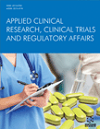- Home
- A-Z Publications
- Applied Clinical Research, Clinical Trials and Regulatory Affairs
- Previous Issues
- Volume 7, Issue 3, 2020
Applied Clinical Research, Clinical Trials and Regulatory Affairs - Volume 7, Issue 3, 2020
Volume 7, Issue 3, 2020
-
-
Genotoxic Impurities in Ranitidine Containing Products: An Overview
More LessAuthors: Shailesh Bhosale, Kamal Kant, Divya Goyal and Anoop KumarRanitidine is a well known H2 blocker antihistaminic drug used for symptomatic relief of heartburn, indigestion, acid indigestion, peptic ulcer and hyperacidity. However, On 13th September 2019, the United States Food and Drug Administration (USFDA) has given an alerting statement regarding the presence of nitrosamine impurity called N-nitrosodimethylamine (NDMA) in ranitidine containing products. Recently, some Read More
-
-
-
A Comprehensive Review of Regulatory Requirements and Registration Process of Pharmaceutical Drug Products in CIS Countries
More LessAuthors: Kapil Pihwal, Neelam Pawar, Sheikh Aamir, Mohammad S. Alam and Vikas RatheeBackground: The CIS region has a potential market for India. The registration of the drug products in CIS regions is a challenging task because these countries have no harmonized regulatory organization. The CIS region includes 12 countries such as Russia, Kyrgyzstan, Ukraine, Uzbekistan, Kazakhstan, Tajikistan, Turkmenistan, Armenia, Azerbaijan, Belarus, Georgia and Moldova, which require different regulatory guidelines f Read More
-
-
-
Safety and Quality of Nutraceuticals: Have FSSAI Guidelines been Able to Blaze the Trail?
More LessAuthors: Payal Dande, Purva Samant, Yashita Singh and Umang ShethThe nutraceutical industry has three main segments, including herbal/- natural products, dietary supplements and functional foods. The dietary supplements market is preliminarily driven by the paradigm shift towards preventive health management practices, amid rising healthcare costs and increasing burden of lifestyle diseases. Rise in healthcare expenditure, increased usage of nutraceuticals product as a substitute to Read More
-
-
-
Raw Data Management and Data Integrity in Pharmaceutical Product Development
More LessAuthors: Jenish Parmar, Priti Mehta, Rajvi Patel, Manan Shah and Charmy KothariIn pharmaceuticals, raw data management is a tedious process that comprises of obtaining the data, affirming the validity, and preserving the required data to make certain of the quality, accuracy, and timeliness of the one who is using the data. Raw data management makes processing, validation, and other essential functions simpler and less time intensive. It provides actual information, i.e., the information which has no Read More
-
-
-
Self-Emulsifying Drug Delivery System (SEDDS) and its Pharmaceutical Applications
More LessPoor aqueous solubility, oral bioavailability, inter, and inter-subject variability, and physical stability have always been a concern for pharmaceutical formulation scientists while formulating an oral dosage form. Self-Emulsifying Drug Delivery System (SEDDS) is a promising new approach to mitigating those potential problems. The main advantages of SEDDS are that it increases the solubility and decreases the bio-degradatio Read More
-
-
-
Nanotechnology: Regulatory Outlook on Nanomaterials and Nanomedicines in United States, Europe and India
More LessAuthors: Rashi Malik and Sharvil PatilBackground: The outlook on “Nano-materials, products, medicine and technology' lacks a consensus on the definition to be considered by regulatory bodies all over the world. Engineered nanoparticles, the formulated products containing nanomaterials, are not subject to any precise regulation pertaining to production, handling and labeling till now. Also, nano medicines holding an immense potential involved in treatm Read More
-
-
-
EU IVDR Regulatory Changes: An Overview of Requirements in (EU) 2017/746
More LessAuthors: Shashank Nayak, M.P. Venkatesh and Pramod K. T.MIVDR is the new regulatory basis for placing IVDs in the market, making them available and putting them into service in the European market. EU IVDR regulation is much bigger than the impact of EU IVDD, which is a bold statement to make, considering the significant industry- wide impact as it presents challenges to the manufacturer. Rather, it is largely a revision that contains guidance on how to fulfill the existing IVDD requir Read More
-
-
-
Comparison of Maternal and Neonatal Outcomes in Case of Primary Cesarean Section Done During Late vs. Early Labor
More LessAuthors: Heena Anuff, Zeinah Rahman, Rajani Dube and Shatha T. S. Al-ZuheiriBackground: Cesarean section (CS) done before the onset of labor is called an elective and done during labor is called an emergency CS. During labor, CS may be needed in early(1st) or late(2nd) stages. Earlier studies have shown more maternal and fetal complications when a cesarean is done for the first time in the late stages. Objective: Our objective was to find out whether the maternal and fetal outcomes differ when p Read More
-
Most Read This Month
Article
content/journals/acctra
Journal
10
5
false
en

Most Cited Most Cited RSS feed
-
-
-
A Rapid LC-ESI-MS/MS Method for the Quantitation of Salicylic Acid, an Active Metabolite of Acetylsalicylic Acid: Application to in vivo Pharmacokinetic and Bioequivalence Study in Indian Healthy Male Volunteers
Authors: Dhiman Halder, Shubhasis Dan, Easha Biswas, Pradipta Sarkar, Umesh C. Halder and Tapan K. Pal
-
- More Less

